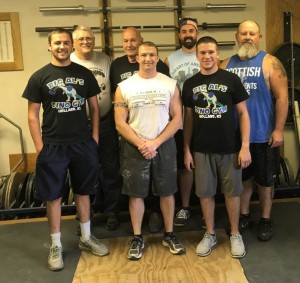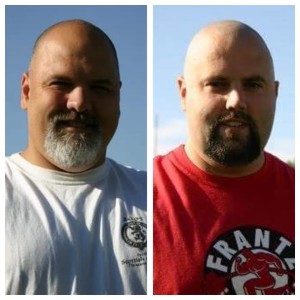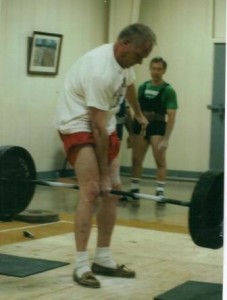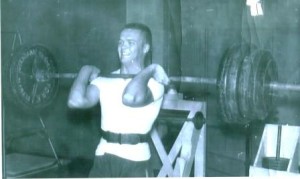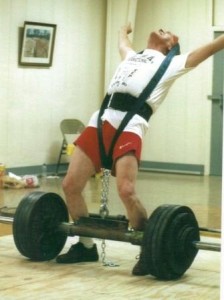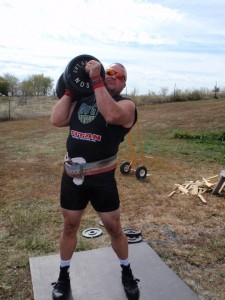Team Championships
By Al Myers
2017 USAWA TEAM CHAMPIONSHIPS
The USAWA has new TEAM CHAMPIONS! The Overall Best Team Lifters in the USAWA for the past 8 years have been myself and my buddy Chad (and Overall winners in 9/10 Team Championships). But that streak is over…. and the dynamic duo of the USAWA is now LaVerne Myers and Dean Ross! These two have been at Team Lifting for many years now and with all that practice, are in tune to each other’s dance steps. The were in perfect synch and picked their attempts with precision. They were the only team to not miss an attempt all day, and finished close to their max on each of their final attempts.
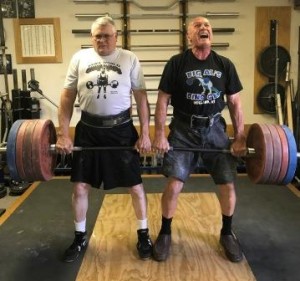
LaVerne Myers (left) and Dean Ross (right) – the OVERALL Best Team at the 2017 USAWA Team Championships.
I was very excited to have 4 teams participate. The young team of Cale Dunlap and Brandon Rein showed great promise. These two will continually improve. They have no idea of what they are capable of yet in the USAWA.
It was great to see John Douglas of the Ledaig Club here for his first Team Championships. He paired with Dino Gym lifter Zach Lucas (since Dave let him down by not making it) and these two put up big lifts, and ended up with the highest TOTAL of the day. They lifted 600 in the Fulton Bar Ciavattone Grip Deadlift, and took a shot at the gym record of 672# held by Chad and myself. It was ah, so close!
I have to thank fellow Dino Gym member Dan Mather for joining me at the last minute (since Chad let me down). This was our first time lifting together in the Team format. We had a great time, and again, I greatly appreciate Dan stepping in so I could lift and not end MY streak of competing in all of the Team Championships.
Meet Results:
2017 USAWA Team Championships
Dino Gym
Abilene, KS
August 26th, 2017
Meet Director: Al Myers
Meet Officials (1-official system): Al Myers and LaVerne Myers
Lifts: Team Bent Arm Pullover, Team Deadlift – Fulton Bar, Ciavattone Grip, Team Deadlift – No Thumbs, Overhand Grip
Teams:
Al Myers (51 years, 229#) and Dan Mather (35 years, 183#) – 105K Class & Open Age Group
Cale Dunlap (22 years, 168#) and Brandon Rein (22 years, 154 pounds) – 80K Class and Open Age Group
John Douglas (53 years, 311#) and Zach Lucas (31 years, 260#) – 125+K Class and Open Age Group
LaVerne Myers (73 years, 240#) and Dean Ross (74 years, 219#) – 110K Class and 70+ Age Group
2-MAN DIVISION
| LIFTERS | PULL | DLCBFB | DLNT | TOT | PTS |
| Myers/Ross | 190 | 500 | 500 | 1190 | 1291.9 |
| Douglas/Lucas | 275 | 600 | 650 | 1525 | 1088.4 |
| Myers/Mather | 230 | 500 | 550 | 1280 | 1062.6 |
| Dunlap/Rein | 170 | 360 | 400 | 930 | 921.6 |
Notes: All lifts recorded in pounds. TOT is total pounds lifted. PTS are overall points adjusted for age and bodyweight corrections.
RECORD DAY LIFTS
LaVerne Myers
Bent Arm Pullover 90#
Clean and Press – Middle Fingers 50#
Deadlift – Stiff Leg 210#
Pinch Grip Deadlift 325#
Deadlift – Dumbbell, Right Arm 195#
Al Myers
Bent Arm Pullover 120#
Clean and Press – Middle Fingers 95#
Deadlift – Stiff Leg 400#
Pinch Grip Deadlift 450#
Lateral Raise – Lying 90#
